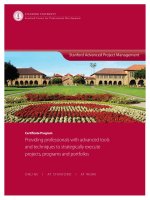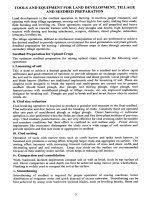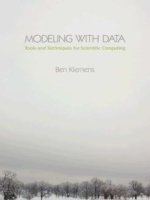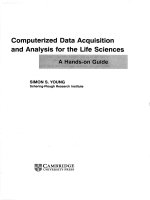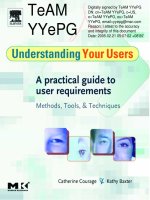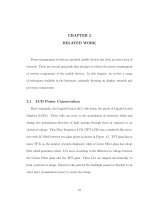modeling with data tools and techniques for scientific computing oct 2008
Bạn đang xem bản rút gọn của tài liệu. Xem và tải ngay bản đầy đủ của tài liệu tại đây (3.69 MB, 471 trang )
gsl_stats July 10, 2008
Modeling with Data
gsl_stats July 10, 2008
gsl_stats July 10, 2008
Modeling with Data
Tools and Techniques for Scientific Computing
Ben Klemens
PRINCETON UNIVERSITY PRESS
PRINCETON AND OXFORD
gsl_stats July 10, 2008
Copyright © 2009 by Princeton University Press
Published by Princeton University Press
41 William Street, Princeton, New Jersey 08540
In the United Kingdom: Princeton University Press
6 Oxford Street, Woodstock, Oxfordshire, OX20 1TW
All Rights Reserved
Klemens, Ben.
Modeling with data : tools and techniques for scientific computing / Ben Klemens.
p. cm.
Includes bibliographical references and index.
ISBN 978-0-691-13314-0 (hardcover : alk. paper)
1. Mathematical statistics. 2. Mathematical models. I. Title.
QA276.K546 2009
519.5–dc22 2008028341
British Library Cataloging-in-Publication Data is available
This book has been composed in L
A
T
E
X
The publisher would like to acknowledge the author of this volume for providing the camera-ready
copy from which this book was printed.
Printed on acid-free paper. ∞
press.princeton.edu
Printed in the United States of America
10 9 8 7 6 5 4 3 2 1
gsl_stats July 10, 2008
We believe that no one should be deprived of books for any reason.
—Russell Wattenberg, founder of the Book Thing
The a uthor pledges to donate 25% o f his royalties to the Book Thing
of Baltimore, a no n-profit that gives books to schools, students,
libraries, and other readers of all kinds.
gsl_stats July 10, 2008
gsl_stats July 10, 2008
CONTENTS
Preface xi
Chapter 1. Statistics in the modern day 1
PART I COMPUTING 15
Chapter 2. C 17
2.1 Lines 18
2.2 Variables a nd their declarations 28
2.3 Functions 34
2.4 The debu gger 43
2.5 Compiling an d running 48
2.6 Pointers 53
2.7 Arrays and other pointer tricks 59
2.8 Strings 65
2.9 Errors 69
Chapter 3. Databases 74
3.1 Basic queries 76
3.2
Doing more with queries 80
3.3 Joins and subquer ies 87
3.4 On database design 94
3.5 Folding queries into C code 98
gsl_stats July 10, 2008
viii CONTENTS
3.6 Maddening details 103
3.7 Some examples 108
Chapter 4. Matrices and models 113
4.1 The GSL’s matrices and vectors 114
4.2 120
4.3 Shunting data 123
4.4 Linear algebra 129
4.5 Numbers 135
4.6 and internals 140
4.7 Models 143
Chapter 5. Graph ics 157
5.1 160
5.2 Some common settings 163
5.3 From arrays to plots 166
5.4 A sampling of s pecial plots 171
5.5 Animation 177
5.6 On producing g ood plots 180
5.7
Graphs—nodes and flowcharts 182
5.8 Printing and L
A
T
E
X 185
Chapter 6. More cod ing tools 189
6.1 Function pointers 190
6.2 Data s tructures 193
6.3 Parameters 203
6.4 Syntactic suga r 210
6.5 More tools 214
PART II STATISTICS 217
Chapter 7. Distributions for des cription 219
7.1 Moments 219
7.2 Sample distributions 235
7.3 Using the sample distribu tions 252
7.4 Non-parametric description 261
Chapter 8. Linear projections 264
8.1
Principal component an alysis 265
8.2 OLS a nd friends 270
8.3 Discrete variables 280
8.4 Multilevel mod eling 288
gsl_stats July 10, 2008
CONTENTS ix
Chapter 9. Hypothesis testing with the CLT 295
9.1 The Centra l Limit Theorem 297
9.2 Meet the Gaussian family 301
9.3 Testing a hypothesis 307
9.4 ANOVA 313
9.5 Regression 315
9.6 Goodness of fit 319
Chapter 10. Maximum likelihood estimation 325
10.1 Log likelihood and friends 326
10.2 Description: Maximum likelihood estimators 337
10.3 Missing data 345
10.4 Testing with likelihoods 348
Chapter 11. Monte Carlo 355
11.1 Random number generation 356
11.2 Description: Finding statistics for a distribution 363
11.3 Inference: Finding statistics for a parameter 366
11.4 Drawing a distribu tion 370
11.5 Non-parametric testing 374
Appendix A: Environments and makefiles 381
A.1 Environment variables 381
A.2 Paths 385
A.3 Make 387
Appendix B: Text processing 392
B.1 Shell scripts 393
B.2 Some tools for scripting 398
B.3 Regular expressions 403
B.4 Adding and deleting 413
B.5 More examples 415
Appendix C: Glossary 419
Bibliography 435
Index 443
gsl_stats July 10, 2008
gsl_stats July 10, 2008
PREFACE
Mathematics provides a framework for dealing precisely with notions of “what is.”
Computation provides a framework for dealing precisely with notions of “how to.”
—Alan J Perlis, in Abelson et al. [1985, p xvi]
SHOULD YOU USE THIS BOOK? This book is intended to be a complement to
the standard stats textbook, in three ways.
First, descriptive and inferential statistics are kept separate beginning with the first
sentence of the first chapter. I believe that the fusing of the two is the number one
cause of confusion among statistics students.
Once descriptive modeling is given its own space, and models do not necessarily
have to be just preparation for a test, the options blossom. There are myriad ways
to convert a subjective understanding of the world into a mathematical model,
including simulations, models like the Bernoulli/Poisson distributions from tradi-
tional probability theory, ordinary least squares, simulations, and who knows what
else.
If those options aren’t enough, simple models can be combined to form multi-
level models to describe situations of arbitrary complexity. That is, the basic linear
model or the Bernoulli/Poisson models may seem too simple for many situations,
but they are building blocks that let us produce more descriptive models. The over-
all approach concludes with multilevel models as in, e.g., Eliason [1993], Pawitan
[2001] or Gelman and Hill [2007].
gsl_stats July 10, 2008
xii PREFACE
Second, many stats texts aim to be as complete as possible, because completeness
and a thick spine give the impression of value-for-money: you get a textbook and
a reference book, so everything you need is guaranteed to be in there somewhere.
But it’s hard to learn from a reference book. So I have made a solid effort to provide
a narrative to the important points about statistics, even though that directly implies
that this book is incomplete relative to the more encyclopædic texts. For example,
moment generating functions are an interesting narrative on their own, but they are
tangential to the story here, so I do not mention them.
Computation The third manner in which this book complements the traditional
stats textbook is that it acknowledges that if you are working with
data full-time, then you are working on a computer full time. The better you un-
derstand computing, the more you will be able to do with your data, and the faster
you will be able to do it.
The po litics of software
All of the software in this book is
free software
,
meaning that it may be freely downloaded and dis-
tributed. This is because the book focuses on porta-
bility and replicability, and if you need to purchase a
license every time you switch computers, then the code
is not portable.
If you redistribute a functioning program that you
wrote based on the GSL or Apophenia, then you need
to redistribute both the compiled final program and the
source code you used to write the program. If you are
publishing an academic work, you should be doing this
anyway. If you are in a situation where you will dis-
tribute only the output of an analysis, there are no obli-
gations at all.
This book is also reliant on
POSIX
-compliant sys-
tems, because such systems were built from the ground
up for writing and running replicable and portable
projects. This does not exclude any current operating
system (OS): current members of the Microsoft Win-
dows family of OSes claim POSIX compliance, as do
all OSes ending in X (Mac OS X, Linux, UNIX, . ).
People like to characterize com-
puting as fast-paced and ever-
changing, but much of that is just
churn on the syntactic surface. The
fundamental concepts, conceived
by mathematicians with an eye to-
ward the simplicity and elegance of
pencil-and-paper math, have been
around for as long as anybody
can remember. Time spent learning
those fundamentals will pay off no
matter what exciting new language
everybody happens to be using this
month.
I spent much of my life ignor-
ing the fundamentals of computing
and just hacking together projects
using the package or language of
the month: C++, Mathematica, Oc-
tave, Perl, Python, Java, Scheme, S-
PLUS, Stata, R, and probably a few others that I’ve forgotten. Albee [1960, p 30]
explains that “sometimes it’s necessary to go a long distance out of the way in or-
der to come back a short distance correctly;” this is the distance I’ve gone to arrive
at writing a book on data-oriented computing using a general and basic computing
language. For the purpose of modeling with data, I have found C to be an easier
and more pleasant language than the purpose-built alternatives—especially after I
worked out that I could ignore much of the advice from books written in the 1980s
and apply the techniques I learned from the scripting languages.
gsl_stats July 10, 2008
PREFACE xiii
WHAT IS THE LEVEL OF THIS BOOK? The short answer is that this is intended
for the graduate student or independent
researcher, either as a supplement to a standard first-year stats text or for later
study. Here are a few more ways to answer that question:
• Ease of use versus ease of initial use: The majority of statistics students are just
trying to slog through their department’s stats requirement so they can never look
at another data set again. If that is you, then your sole concern is ease of initial use,
and you want a stats package and a textbook that focus less on full proficiency and
more on immediate intuition.
1
Conversely, this book is not really about solving today’s problem as quickly as
physically possible, but about getting a better understanding of data handling, com-
puting, and statistics. Ease of long-term use will follow therefrom.
• Level of c omputing abstraction: This book takes the fundamentals of computing
seriously, but it is not about reinventing the wheels of statistical computing. For
example,
Numerical Recipes in C
[Press et al., 1988] is a classic text describing the
algorithms for seeking optima, efficiently calculating determinants, and making
random draws from a Normal distribution. Being such a classic, there are many
packages that implement algorithms on its level, and this book will build upon
those packages rather than replicate their effort.
• Computing experien ce: You may have never taken a computer science course, but
do have some experience in both the basics of dealing with a computer and in
writing scripts in either a stats package or a scripting language like Perl or Python.
• Computational detail: This book includes about 90 working sample programs.
Code clarifies everything: English text may have a few ambiguities, but all the
details have to be in place for a program to execute correctly. Also, code rewards
the curious, because readers can explore the data, find out to what changes a pro-
cedure is robust, and otherwise productively break the code.
That means that this book is not computing-system-agnostic. I have made every ef-
fort to make this book useful to people who have decided to not use C, the GSL, or
Apophenia, which means that the more tedious details of these various systems are
left to online manuals. But I have tried to include at least enough about the quirks
of these various systems so that you can understand and modify the examples.
• Linear algebra: You are reasonably familiar with linear algebra, such that an ex-
pression like X
−1
is not foreign to you. There are a countably infinite number of
linear algebra tutorials in books, stats text appendices, and online, so this book
does not include yet another.
• Statistical topics: The book’s statistical topics are not particularly advanced or
trendy: OLS, maximum likelihood, or bootstrapping are all staples of first-year
grad-level stats. But by creatively combining building blocks such as these, you
will be able to model data and situations of arbitrary complexity.
1
I myself learned a few things from the excellently written narrative in Gonick and Smith [1994].
gsl_stats July 10, 2008
gsl_stats July 10, 2008
Modeling with Data
gsl_stats July 10, 2008
gsl_stats July 10, 2008
1
STATISTICS IN THE MODERN DAY
Retake the falling snow: each drifting flake
Shapeless and slow, unsteady and opaque,
A dull dark white against the day’s pale white
And abstract larches in the neutral light.
—Nabokov [1962, lines 13–16]
Statistical analysis has two goals, which directly conflict. The first is to find pat-
terns in static: given the infinite number of variables that one could observe, how
can one discover the relations and patterns that make human sense? The second
goal is a fight against
apophenia
, the human tendency to invent patterns in random
static. Given that someone has found a pattern regarding a handful of variables,
how can one verify that it is not just the product of a lucky draw or an overactive
imagination?
Or, consider the complementary dichotomy of objective versus subjective. The
objective side is often called
probability
; e.g., given the assumptions of the Central
Limit Theorem, its conclusion is true with mathematical certainty. The subjective
side is often called
statistics
; e.g., our claim that observed quantity A is a linear
function of observed quantity B may be very useful, but Nature has no interest in
it.
This book is about writing down subjective models based on our human under-
standing of how the world works, but which are heavily advised by objective in-
formation, including both mathematical theorems and observed data.
1
1
Of course, human-gathered data is never perfectly objective, but we all try our best to make it so.
gsl_stats July 10, 2008
2 CHAPTER 1
The typical scheme begins by proposing a model of the world, then estimating the
parameters of the model using the observed data, and then evaluating the fit of the
model. This scheme includes both a descriptive step (describing a pattern) and an
inferential step (testing whether there are indications that the pattern is valid). It
begins with a subjective model, but is heavily advised by objective data.
Figure 1.1 shows a model in flowchart form. First, the descriptive step: data and
parameters are fed into a function—which may be as simple as a
is correlated
to
b, or may be a complex set of interrelations—and the function spits out some
output. Then comes the testing step: evaluating the output based on some criterion,
typically regarding how well it matches some portion of the data. Our goal is to
find those parameters that produce output that best meets our evaluation criterion.
Dta1 Dta2
Function EvaluationParameters Output
Figure 1.1 A flowchart for distribution fitting, linear regression, maximum likelihood methods,
multilevel modeling, simulation (including agent-based modeling), data mining, non-
parametric modeling, and various other methods. [Online source for the diagram:
.]
The Ordinary Least Squares (OLS) model is a popular and familiar example, pic-
tured in Figure 1.2. [If it is not familiar to you, we will cover it in Chapter 8.] Let
X indicate the independent data, β the parameters, and y the dependent data. Then
the function box consists of the simple equation y
out
= Xβ, and the evaluation
step seeks to minimize squared error, (y − y
out
)
2
.
Dta1 Dta2
xpxi diffPrm yout
Figure 1.2 The OLS model: a special case of Figure 1.1.
For a simulation, the function box may be a complex flowchart in which variables
are combined non-linearly with parameters, then feed back upon each other in
unpredictable ways. The final step would evaluate how well the simulation output
corresponds to the real-world phenomenon to be explained.
The key computational problem of statistical modeling is to find the parameters at
gsl_stats July 10, 2008
STATISTICS IN THE MODERN DAY 3
the beginning of the flowchart that will output the best evaluation at the end. That
is, for a given function and evaluation in Figure 1.1, we seek a routine to take in
data and produce the optimal parameters, as in Figure 1.3. In the OLS model above,
there is a simple, one-equation solution to the problem: β
best
= (X
′
X)
−1
X
′
y.
But for more complex models, such as simulations or many multilevel models, we
must strategically try different sets of parameters to hunt for the best ones.
Data Estimation Parameters
Data Estimation Parameters
Figure 1.3 Top: the parameters which are the input for the model in Figure 1.1 are the output for the
estimation routine.
Bottom: the estimation of the OLS model is a simple equation.
And that’s the whole book: develop models whose parameters and tests may dis-
cover and verify interesting patterns in the data. But the setup is incredibly versa-
tile, and with different function specifications, the setup takes many forms. Among
a few minor asides, this book will cover the following topics, all of which are vari-
ants of Figure 1.1:
• Probability: how well-known distributions can be used to model data
• Projections: summarizing many-dimensional data in two or three dimensions
• Estimating linear models such as OLS
• Classical hypothesis testing: using the Central Limit Theorem (CLT) to ferret out
apophenia
• Designing multilevel models, where one model’s output is the input to a parent
model
• Maximum likelihood estimation
• Hypothesis testing using likelihood ratio tests
• Monte Carlo methods for describing parameters
• “Nonparametric” modeling (which comfortably fits into the parametric form here),
such as smoothing data distributions
• Bootstrapping to describe parameters and test hypotheses
gsl_stats July 10, 2008
4 CHAPTER 1
THE SNOWFLAKE PROBLEM, OR A BRIEF
HISTORY OF STATISTICAL COMPUTING
The simplest models in the above
list have only one or two param-
eters, like a Binomial(n, p) distri-
bution which is built from n identical draws, each of which is a success with
probability p [see Chapter 7]. But draws in the real world are rarely identical—
no two snowflakes are exactly alike. It would be nice if an outcome variable, like
annual income, were determined entirely by one variable (like education), but we
know that a few dozen more enter into the picture (like age, race, marital status,
geographical location, et cetera).
The problem is to design a model that accommodates that sort of complexity, in
a manner that allows us to actually compute results. Before computers were com-
mon, the best we could do was analysis of variance methods (ANOVA), which
ascribed variation to a few potential causes [see Sections 7.1.3 and 9.4].
The first computational milestone, circa the early 1970s, arrived when civilian
computers had the power to easily invert matrices, a process that is necessary for
most linear models. The linear models such as ordinary least squares then became
dominant [see Chapter 8].
The second milestone, circa the mid 1990s, arrived when desktop computing power
was sufficient to easily gather enough local information to pin down the global op-
timum of a complex function—perhaps thousands or millions of evaluations of the
function. The functions that these methods can handle are much more general than
the linear models: you can now write and optimize models with millions of inter-
acting agents or functions consisting of the sum of a thousand sub-distributions
[see Chapter 10].
The ironic result of such computational power is that it allows us to return to the
simple models like the Binomial distribution. But instead of specifying a fixed n
and p for the entire population, every observation could take on a value of n that is
a function of the individual’s age, race, et cetera, and a value of p that is a different
function of age, race, et cetera [see Section 8.4].
The models in Part II are listed more-or-less in order of complexity. The infinitely
quotable Albert Einstein advised, “make everything as simple as possible, but not
simpler.” The Central Limit Theorem tells us that errors often are Normally dis-
tributed, and it is often the case that the dependent variable is basically a linear or
log-linear function of several variables. If such descriptions do no violence to the
reality from which the data were culled, then OLS is the method to use, and using
more general techniques will not be any more persuasive. But if these assumptions
do not apply, we no longer need to assume linearity to overcome the snowflake
problem.
gsl_stats July 10, 2008
STATISTICS IN THE MODERN DAY 5
THE PIPELINE A statistical analysis is a guided series of transformations of the
data from its raw form as originally written down to a simple
summary regarding a question of interest.
The flow above, in the statistics textbook tradition, picked up halfway through the
analysis: it assumes a data set that is in the correct form. But the full pipeline goes
from the original messy data set to a final estimation of a statistical model. It is
built from functions that each incrementally transform the data in some manner,
like removing missing data, selecting a subset of the data, or summarizing it into a
single statistic like a mean or variance.
Thus, you can think of this book as a catalog of pipe sections and filters, plus a
discussion of how to fit pipe sections together to form a stream from raw data to
final publishable output. As well as the pipe sections listed above, such as the
ordinary least squares or maximum likelihood procedures, the book also covers
several techniques for directly transforming data, computing statistics, and welding
all these sections into a full program:
• Structuring programs using modular functions and the
stack
of
frames
• Programming tools like the debugger and profiler
• Methods for reliability testing functions and making them more robust
• Databases, and how to get them to produce data in the format you need
• Talking to external programs, like graphics packages that will generate visualiza-
tions of your data
• Finding and using pre-existing functions to quickly estimate the parameters of a
model from data.
• Optimization routines: how they work and how to use them
• Monte Carlo methods: getting a picture of a model via millions of random draws
To make things still more concrete, almost all of the sample code in this book
is available from the book’s Web site, linked from
. This means that you can learn by running and modify-
ing the examples, or you can cut, paste, and modify the sample code to get your
own analyses running more quickly. The programs are listed and given a complete
discussion on the pages of this book, so you can read it on the bus or at the beach,
but you are very much encouraged to read through this book while sitting at your
computer, where you can run the sample code, see what happens given different
settings, and otherwise explore.
Figure 1.4 gives a typical pipeline from raw data to final paper. It works at a number
of different
layers of abstraction
: some segments involve manipulating individual
numbers, some segments take low-level numerical manipulation as given and op-
gsl_stats July 10, 2008
6 CHAPTER 1
Input
Data
SQL
Database
Appendix B
C Matrix
Ch 3
Output
parameters
Part II
Plots
and graphs
Ch 5
Figure 1.4 Filtering from input data to outputs. [Online source: ]
erate on database tables or matrices, and some segments take matrix operations as
given and run higher-level hypothesis tests.
The lowest level Chapter 2 presents a tutorial on the C programming language it-
self. The work here is at the lowest level of abstraction, covering
nothing more difficult than adding columns of numbers. The chapter also discusses
how C facilitates the development and use of
libraries
: sets of functions written by
past programmers that provide the tools to do work at higher and higher levels of
abstraction (and thus ignore details at lower levels).
2
For a number of reasons to be discussed below, the book relies on the C program-
ming language for most of the pipe-fitting, but if there is a certain section that
you find useful (the appendices and the chapter on databases comes to mind) then
there is nothing keeping you from welding that pipe section to others using another
programming language or system.
Dealing w ith large data sets Computers today are able to crunch numbers a hun-
dred times faster they did a decade ago—but the data
sets they have to crunch are a thousand times larger. Geneticists routinely pull
550,000 genetic markers each from a hundred or a thousand patients. The US
Census Bureau’s 1% sample covers almost 3 million people. Thus, the next layer
of abstraction provides specialized tools for dealing with data sets: databases and
a query language for organizing data. Chapter 3 presents a new syntax for talking
to a database, Structured Query Language (SQL). You will find that many types
of data manipulation and filtering that are difficult in traditional languages or stats
packages are trivial—even pleasant—via SQL.
2
Why does the book omit a linear algebra tutorial but include an extensive C tutorial? Primarily because the
use of linear algebra has not changed much this century, while the use of C has evolved as more libraries have
become available. If you were writing C code in the early 1980s, you were using only the standard library and
thus writing at a very low level. In the present day, the process of writing code is more about joining together
libraries than writing from scratch. I felt that existing C tutorials and books focused too heavily on the process of
writing from scratch, perpetuating the myth that C is appropriate only for low-level bit shifting. The discussion
of C here introduces tools like package managers, the debugger, and the
utility as early as possible, so you
can start calling existing libraries as quickly and easily as possible.
gsl_stats July 10, 2008
STATISTICS IN THE MODERN DAY 7
As Huber [2000, p 619] explains: “Large real-life problems always require a com-
bination of database management and data analysis. . . . Neither database manage-
ment systems nor traditional statistical packages are up to the task.” The solution is
to build a pipeline, as per Figure 1.4, that includes both database management and
statistical analysis sections. Much of graceful data handling is in knowing where
along the pipeline to place a filtering operation. The database is the appropriate
place to filter out bad data, join together data from multiple sources, and aggregate
data into group means and sums. C matrices are appropriate for filtering operations
like those from earlier that took in data, applied a function like (X
′
X)
−1
X
′
y, and
then measured (y
out
− y)
2
.
Because your data probably did not come pre-loaded into a database, Appendix
B discusses text manipulation techniques, so when the database expects your data
set to use commas but your data is separated by erratic tabs, you will be able to
quickly surmount the problem and move on to analysis.
Computation The GNU Scientific Library works at the numerical computation
layer of abstraction. It includes tools for all of the procedures com-
monly used in statistics, such as linear algebra operations, looking up the value
of F, t, χ
2
distributions, and finding maxima of likelihood functions. Chapter 4
presents some basics for data-oriented use of the GSL.
The Apophenia library, primarily covered in Chapter 4, builds upon these other
layers of abstraction to provide functions at the level of data analysis, model fitting,
and hypothesis testing.
Pretty pictures Good pictures can be essential to good research. They often reveal
patterns in data that look like mere static when that data is pre-
sented as a table of numbers, and are an effective means of communicating with
peers and persuading grantmakers. Consistent with the rest of this book, Chapter 5
will cover the use of Gnuplot and Graphviz, two packages that are freely available
for the computer you are using right now. Both are entirely automatable, so once
you have a graph or plot you like, you can have your C programs autogenerate
it or manipulate it in amusing ways, or can send your program to your colleague
in Madras and he will have no problem reproducing and modifying your plots.
3
Once you have the basics down, animation and real-time graphics for simulations
are easy.
3
Following a suggestion by Thomson [2001], I have chosen the gender of representative agents in this book
by flipping a coin.
gsl_stats July 10, 2008
8 CHAPTER 1
WHY C? You may be surprised to see a book about modern statistical comput-
ing based on a language composed in 1972. Why use C instead of a
specialized language or package like SAS, Stata, SPSS, S-Plus, SAGE, SIENA,
SUDAAN, SYSTAT, SST, SHAZAM, J, K, GAUSS, GAMS, GLIM, GENSTAT,
GRETL, EViews, Egret, EQS, PcGive, MatLab, Minitab, Mupad, Maple, Mplus,
Maxima, MLn, Mathematica, WinBUGS, TSP, HLM, R, RATS, LISREL, Lisp-
Stat, LIMDEP, BMDP, Octave, Orange, OxMetrics, Weka, or Yorick? This may
be the only book to advocate statistical computing with a general computing lan-
guage, so I will take some time to give you a better idea of why modern numerical
analysis is best done in an old language.
One of the side effects of a programming language being stable for so long is that a
mythology builds around it. Sometimes the mythology is outdated or false: I have
seen professional computer programmers and writers claim that simple structures
like linked lists always need to be written from scratch in C (see Section 6.2 for
proof otherwise), that it takes ten to a hundred times as long to write a program in
C than in a more recently-written language like R, or that because people have used
C to write device drivers or other low-level work, it can not be used for high-level
work.
4
This section is partly intended to dispel such myths.
Is C a hard language? C was a hard language. With nothing but a basic 80s-era
compiler, you could easily make many hard-to-catch mis-
takes. But programmers have had a few decades to identify those pitfalls and build
tools to catch them. Modern compilers warn you of these issues, and debuggers let
you interact with your program as it runs to catch more quirks. C’s reputation as a
hard language means the tools around it have evolved to make it an easy language.
Computational speed—really Using a stats package sure beats inverting matri-
ces by hand, but as computation goes, many stats
packages are still relatively slow, and that slowness can make otherwise useful
statistical methods infeasible.
R and Apophenia use the same C code for doing the Fisher exact test, so it makes
a good basis for a timing test.
5
Listings 1.5 and 1.6 show programs in C and R
(respectively) that will run a Fisher exact test five million times on the same data
set. You can see that the C program is a bit more verbose: the steps taken in lines
3–8 of the C code and lines 1–6 of the R code are identical, but those lines are
4
Out of courtesy, citations are omitted. This section makes frequent comparisons to R partly because it is a
salient and common stats package, and partly because I know it well, having used it on a daily basis for several
years.
5
That is, if you download the source code for R’s
function, you will find a set of procedures
written in C. Save for a few minor modifications, the code underlying the
function
is line-for-line identical.
